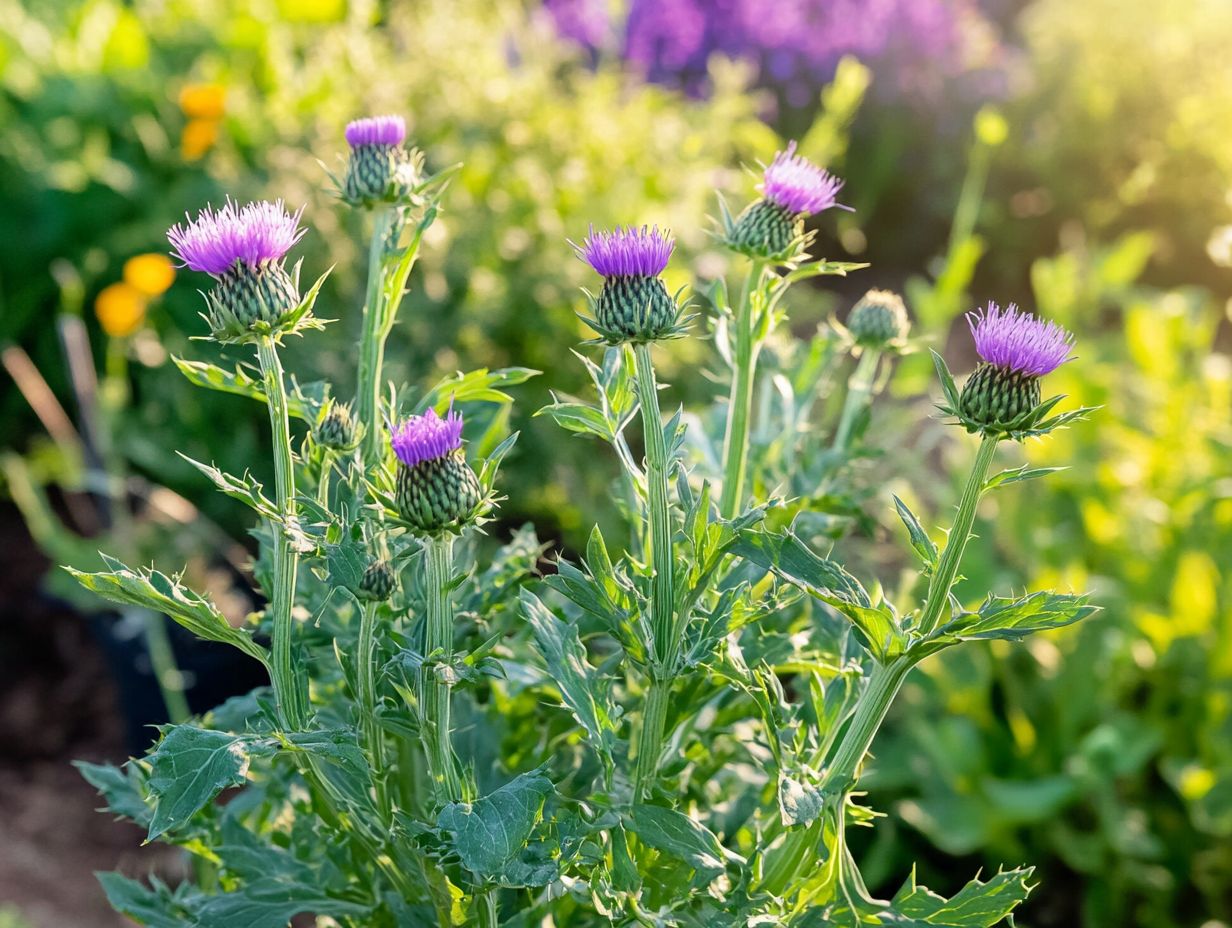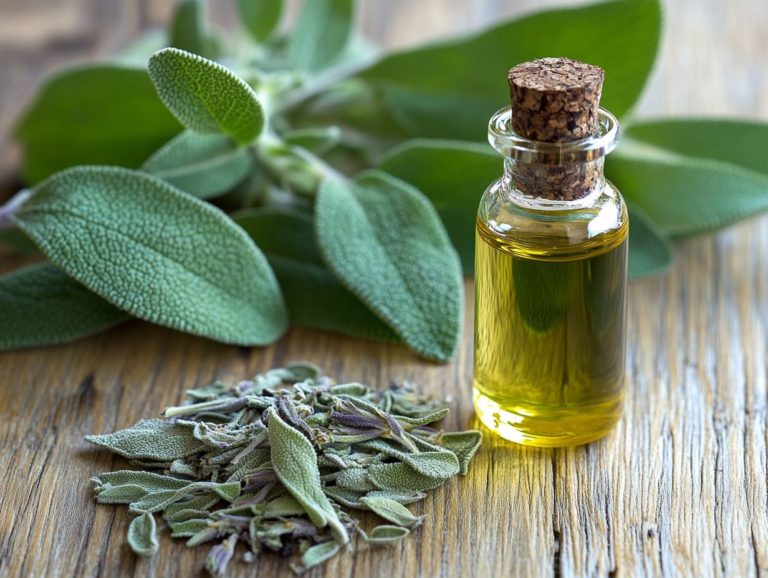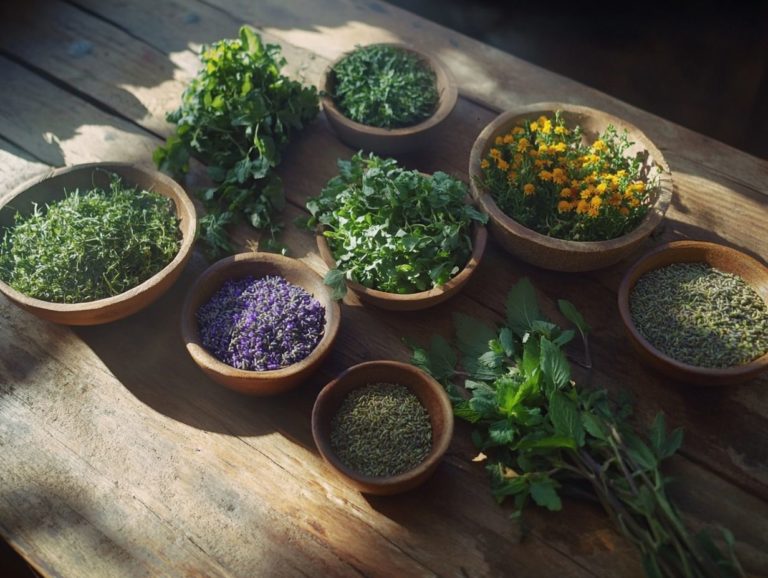The Therapeutic Uses of Milk Thistle
Milk thistle, with its captivating purple blooms, has earned a revered place in the annals of herbal medicine for centuries. It showcases its effectiveness in managing liver disease and its antioxidant properties.
This journey will take you through its rich history and traditional uses. Discover how this ancient remedy has remarkably endured through the ages!
You ll uncover its active components and their mechanisms. Explore its diverse therapeutic applications, and receive expert guidance on how to utilize it effectively.
You ll also learn about potential side effects, such as allergic reactions, and interactions. This ensures you have a well-rounded understanding of milk thistle s benefits and necessary precautions.
Contents
- Key Takeaways:
- What is Milk Thistle?
- History and Traditional Uses
- Active Components and Mechanisms of Action
- Therapeutic Uses of Milk Thistle
- How to Use Milk Thistle
- Potential Side Effects and Interactions
- Frequently Asked Questions
- What is milk thistle and how is it used therapeutically?
- What are the potential therapeutic uses of milk thistle?
- How does milk thistle work in the body?
- Are there any other potential benefits of milk thistle?
- Is milk thistle safe to use and are there any side effects?
- What is the recommended dosage and form of milk thistle for therapeutic use?
Key Takeaways:

- Milk thistle has been used for its medicinal properties since ancient times, with documented use dating back to the first century AD.
- The active components in milk thistle protect and promote the regeneration of liver cells. They have been used to treat liver diseases such as cirrhosis, hepatitis, and fatty liver disease.
- Milk thistle is available in various forms, and recommended dosages vary depending on the condition being treated. It is generally safe but may interact with certain medications.
What is Milk Thistle?
Milk thistle, scientifically referred to as Silybum marianum, is a remarkable flowering plant from the Asteraceae family. It is revered as an herbal remedy and has garnered attention for its active compound, silymarin.
This compound is celebrated for its powerful antioxidant properties, which help in fighting damage caused by free radicals in the body. It also has potential health benefits, particularly in promoting liver function and aiding in the management of liver disease.
History and Traditional Uses
The history of milk thistle is both rich and varied, with its roots in traditional medicine extending back thousands of years. Ancient cultures recognized its remarkable value for enhancing digestive health and supporting liver function.
Origins and Historical Uses
Milk thistle, with its roots in the Mediterranean, has been cherished for its remarkable therapeutic properties. It particularly addresses liver-related ailments and gastrointestinal issues.
The ancient Greeks were among the first to document its medicinal benefits. Hippocrates utilized it to tackle a range of liver disorders. Fast forward to medieval Europe, where herbalists deemed milk thistle essential for detoxification, often prescribing it to alleviate symptoms linked to liver and digestive health.
Traditional Chinese medicine also recognized this extraordinary herb, highlighting its role in promoting overall well-being. Today, milk thistle continues to captivate those in search of natural remedies, firmly establishing its significance in both historical and contemporary herbal practices.
Active Components and Mechanisms of Action

The key active component of milk thistle, silymarin, is a sophisticated blend of flavonoids extracted from the plant s seeds. This remarkable compound is revered for its potential to support liver function and combat oxidative stress.
Oxidative stress is the damage caused by free radicals in the body, and silymarin provides antioxidant properties that may offer protection against a range of chronic conditions.
Ready to explore the benefits of milk thistle?
Key Components and How They Work
Silymarin, the powerhouse active ingredient in milk thistle, is a blend of several flavonoids that work together to enhance your liver health, help your immune system, and offer robust antioxidant protection against cellular damage.
Among its standout components, silibinin captures attention for its remarkable ability to stabilize cell membranes and promote the regeneration of liver cells. This is particularly relevant in cases of hepatic diseases like hepatitis and cirrhosis.
Another key component is silychristin, which shows great promise in reducing inflammation within the liver, aiding your recovery from oxidative stress. Don t overlook silydianin, as it plays a vital role in stimulating bile production, which enhances your digestion and detoxification processes.
These compounds also have powerful antioxidant properties, neutralizing harmful free radicals and bolstering your immune system. This support is essential for anyone navigating the challenges of liver-related conditions.
Therapeutic Uses of Milk Thistle
Milk thistle is highly esteemed for its therapeutic benefits, especially in addressing liver ailments like fatty liver disease, cirrhosis, and hepatitis C. Its reputation as a natural treatment option for those grappling with these conditions speaks volumes about its potential effectiveness.
Medical Conditions Treated
People have celebrated milk thistle for its amazing benefits in a variety of medical conditions, including liver diseases, type 2 diabetes, and even as a complementary option in cancer treatments, particularly for cases like breast cancer.
This herbal remedy promotes liver health by protecting liver cells from damage inflicted by toxins, a prevalent concern in many liver disorders. It may also significantly help manage type 2 diabetes by assisting with blood sugar regulation and enhancing insulin sensitivity, which means how well your body uses insulin.
Research indicates milk thistle could provide promising effects in cancer treatment, especially for those facing a diagnosis of breast cancer. It may help reduce the proliferation of cancer cells and boost the effectiveness of standard therapies.
These multifaceted benefits establish milk thistle as a valuable consideration in any comprehensive healthcare strategy.
How to Use Milk Thistle

To fully enjoy the health benefits of milk thistle, it’s crucial to know the right way to use it. This includes understanding the recommended dosages, the various forms it comes in, and important considerations if you’re looking to integrate it into your daily routine as a dietary supplement.
Forms and Dosage Recommendations
Milk thistle comes in a variety of forms, such as capsules, tinctures, and teas. You can typically take between 140 mg and 800 mg of silymarin each day, depending on the health benefits you re seeking.
If you’re looking for liver support, capsules might be particularly convenient. They offer a standardized dosage of silymarin, the active compound in milk thistle. Tinctures can provide faster absorption, which may be advantageous for digestive health.
If you prefer a more leisurely approach, sipping on milk thistle tea can turn into a delightful daily ritual for a lighter intake.
It s essential to consider your individual health conditions. For example, if you have existing liver issues, you might need higher dosages under medical supervision, while those focusing on general wellness could comfortably stick to the lower end of the dosage spectrum.
Consulting with a healthcare professional before starting any herbal supplement, including milk thistle, is a wise step to determine the most effective form and dosage tailored to your specific needs.
Potential Side Effects and Interactions
Be aware of possible side effects, as they can affect your health. Milk thistle is typically regarded as safe for most people, but potential side effects can include gastrointestinal issues and allergic reactions. Interactions with specific medications also deserve your careful attention.
Start your journey to better liver health with milk thistle today!
Possible Adverse Reactions and Drug Interactions
Possible adverse reactions to milk thistle may include digestive disturbances and allergic reactions. Be aware of these risks. This herbal supplement may interact with medications that affect liver enzymes. It’s essential to monitor your health closely and consult with healthcare professionals.
If you’re considering incorporating this supplement into your routine, keep in mind its potential side effects, such as nausea, diarrhea, or headaches. These can vary in intensity. Milk thistle might impact the effectiveness of certain medications, especially those metabolized by certain liver enzymes (like cytochrome P450). This interaction could either increase toxicity or diminish the effectiveness of those drugs. Discuss any current medications with your healthcare provider before starting milk thistle.
If you have existing allergies to plants in the Asteraceae family, proceed with caution, as you may experience heightened allergic reactions.
Frequently Asked Questions

What is milk thistle and how is it used therapeutically?
Milk thistle is a plant native to Europe and Asia, traditionally used as a herbal remedy for liver and gallbladder problems. Today, it is commonly used as a dietary supplement for its potential therapeutic effects.
What are the potential therapeutic uses of milk thistle?
Milk thistle has been studied for its potential therapeutic effects in treating liver diseases such as cirrhosis, hepatitis, and fatty liver disease. It may also help manage conditions like type 2 diabetes. Additionally, it supports liver function and protects against liver damage caused by toxins and medications.
How does milk thistle work in the body?
The active ingredient in milk thistle is a flavonoid called silymarin. It is believed to have antioxidant properties and neuroprotective effects. Silymarin helps protect liver cells from damage and promotes their regeneration.
Are there any other potential benefits of milk thistle?
Besides its potential therapeutic uses for the liver, milk thistle has been studied for its effects on conditions like type 2 diabetes, high cholesterol, and breast cancer. However, more medical research is needed to determine its effectiveness for these uses, especially regarding cancer treatment and cholesterol management.
Is milk thistle safe to use and are there any side effects?
Milk thistle is generally considered safe for most people when taken in appropriate doses. However, safety concerns should be discussed with a healthcare provider, especially for those with gastrointestinal issues or allergic reactions. Some people may experience mild side effects such as upset stomach, diarrhea, or allergic reactions. Always consult your healthcare provider before starting any new dietary supplements, particularly if you have chronic conditions or are taking diabetes medications.
What is the recommended dosage and form of milk thistle for therapeutic use?
The recommended dosage of milk thistle varies depending on the condition being treated, typically ranging from 200-600 mg per day. This can differ based on issues like liver inflammation or digestive health. Milk thistle is available in capsule, tablet, liquid extract, and tea form, making it a versatile herbal remedy. Choose a reputable brand and follow the dietary recommendations on the product label to avoid potential side effects and ensure optimal benefits.
For more information about milk thistle and its uses, consult your healthcare provider or do further research.






